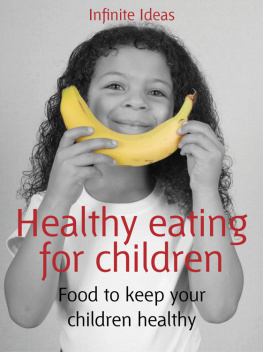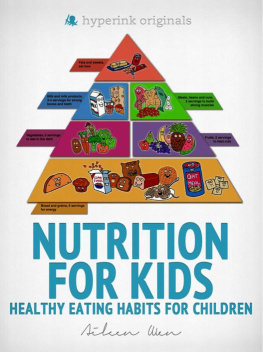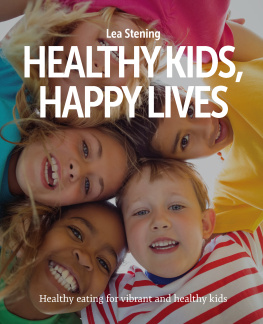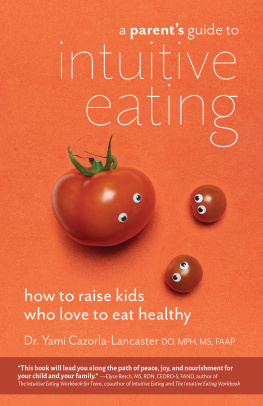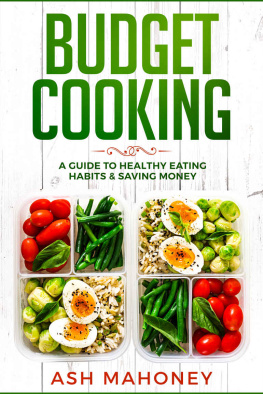Healthy eating for children
Food to keep your children healthy
Infinite Ideas with Mandy Francis
Previously published in paperback as Healthy cooking for children

7. The white stuff
Follow-on formula, cows milk, semi-skimmed or full fat? How much milk and how often? Youll find the answers here.
Milk should remain an important part of your childs diet, even after he starts on solids.
The Department of Health recommends breast milk or infant formula for babies up to the age of twelve months. After that time, full fat cows milk may be given instead.
Cows milk is not suitable for babies under six months old, because their immature digestive systems are unable to process the protein and salt that it contains. Cows milk is not currently recommended for babies under the age of one year either, as it is low in iron and vitamin C two nutrients essential to growing babies.
From twelve months onwards, however, milk should still play an important role in your babys diet, as it provides essential calcium, protein, vitamins and minerals. Ideally, your toddler needs to have a minimum of 350ml ( /3 pint) of full fat cows milk each day until hes two years old.
Full fat cows milk should be given to your baby until he is two years old in preference to skimmed or semi-skimmed, because your child still needs the energy that the fat in milk provides to grow. The fat in the milk also helps to carry essential vitamins A and D. After he reaches his second birthday you can swap down to semi-skimmed milk if you wish.
Other types of milk when and why?
- Follow-on milk is a formula milk with a higher protein and mineral content than regular infant formula. It is suitable for babies over six months old, and advertised as being more nutritious than cows milk. Its not essential, however. Most experts recommend meeting your childs increasing nutritional needs as he grows with more of his standard formula, plus calcium and iron-rich foods. That said, the ready-made cartons of follow-on milk, which dont need refrigerating unless opened, can be handy for travelling and days out.
- Soya-based formula is made from soya beans, which are modified for use in formula with vitamins, minerals and nutrients. Babies should only be given soya-based formula on the advice of a health professional, such as a health visitor, GP or dietician.
- Goats milk is not suitable for babies and infant formulas and follow-on formulas based on goats milk have not been approved for use in Europe. There is a belief that infant formula and follow-on formula based on goats milk protein are suitable alternatives for babies who are intolerant or allergic to cows milk formulas. However, some of the proteins in goats milk are similar to those found in cows milk and most babies that react to cows milk protein are also likely to react to goats milk protein. Since the levels of lactose are similar in both milks, formulas derived from goats milk are also unsuitable for babies that are lactose-intolerant.
Cows milk intolerance and allergy
Around 13% of all babies will develop a cows milk intolerance or allergy. Symptoms include persistent crying, weight loss or no weight gain, reflux, vomiting, colic, burping, flatulence, diarrhoea, constipation, skin rashes and shortness of breath. If your child has any of these symptoms see your GP immediately for a diagnosis.
Cows milk intolerance is an intolerance to either milk protein or lactose, a sugar found in cows milk. Tests need to be done to establish whether the child has a milk protein or lactose intolerance. If your baby has an intolerance of cows milk protein he may still be able to have some cows milk and cows milk products.
Lactose intolerance is caused by lactase deficiency, the enzyme in the body that digests milk. If lactase deficiency is diagnosed, your baby might be put on a low lactose diet which may allow low lactose milk and milk products.
If your baby is found to have a cows milk protein allergy, rather than a simple intolerance, cows milk and associated products will have to be excluded from his diet completely.
The good news is, up to 90% of children will eventually outgrow their cows milk allergies, and cows milk protein intolerance.
How did it go?
QMy babys seven months old now and I want to give up breastfeeding. I know cows milk is unsuitable until she is one so should I give her formula in a bottle?
AIf you wean your baby from the breast when she is six months or more, you may be able to bypass bottles completely. The sucking action required for breast or bottle feeding is not as necessary to your baby now as it was when she was younger. She should be able to take most of her drinks from a feeder cup, or beaker. She may, however, still prefer to have a bottle or breastfeed last thing at night for comfort.
QWhat sort of beaker are we talking about?
AIts best to start with a spill-proof beaker with a soft spout. Youll find plenty of different styles in your local pharmacy or supermarket. You could use expressed milk in it at first to get her used to it before you swap to formula.
QWhy is a beaker preferable to a bottle and teat?
AExperts recommend transferring to a cup because using a bottle, especially as a comforter, can damage teeth, as drinks are swilled around the mouth for long periods of time.
Heres an idea for you
If your child goes off milk drinks before she reaches her second birthday try offering two portions of calcium-rich foods a day to top up her diet. Yoghurt, cheese, tinned mashed sardines and fortified white bread all contain useful levels of calcium.
Defining idea
There are three reasons for breast-feeding: the milk is always at the right temperature; it comes in attractive containers; and the cat cant get it.
IRENA CHALMERS, American cookery writer and publisher
8. Up and running
The pre-school years are when the foundations for balanced eating and future good health are laid.
Now weaning is over youve reached a crucial time in your childs dietary development.
A childs diet needs careful handling now. She needs lots of nutrients and energy, but her appetite is likely to be small, and she may be a bit fussy about her food. Small, frequent and nutrient-dense meals are the order of the day.
The best foods for your pre-school child are divided into four main groups and a fifth or occasional group. If you base your childs diet on these groups you can be certain that shell be getting all the important nutrients she needs at this age.
Group 1: Starchy carbohydrates
Some bread, rice, pasta, cereals and potatoes should be served with all meals. An average portion of starchy carbohydrates for a pre-school child might be one slice of bread or two tablespoons of cereal, pasta or rice or a small baked potato.
- Vary the way you serve potatoes and the types of bread you offer think granary, rolls, pittas, chapattis, bagels and breadsticks.
- Buy interesting pasta shapes to encourage your child to eat well.
- Serve fortified breakfast cereals (those that have added vitamins and minerals) or porridge first thing.
Group 2: Fruit and vegetables
These should also be eaten often. Aim for five portions a day. A portion of fruit for a child of this age would be a small whole fruit or half a large fruit (e.g. half a large apple, orange or pear), two tablespoons of berries or eight grapes. A portion of vegetables would be one to two heaped tablespoons of cooked veg or two broccoli florets or a small sliced carrot.
- Fruit makes a great dessert or snack ring the changes often.
- Dont forget to offer vegetable crudits for snacks.
Next page
